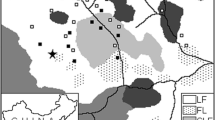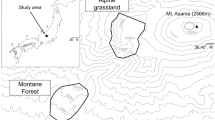Summary
Overlap in the diets of 14 species of grasshoppers on mixed-grass prairie in northeastern Colorado was estimated by microscopic examination of crop contents. Food availability estimates, taken by a weight-estimate method, facilitated the determination of food preferences. Two cases of high overlap in diets and period of habitat occupancy occurred between species which consumed equal or almost equal numbers of different foods (foodniche breadth) and had almost identical foraging behavior. The first case occurred early in the season between Xanthippus corallipes and Arphia conspersa with foodniche breadths of 14 and 11, respectively. The second case occurred later in the season between Amphitornus coloradus and Trachyrhachys kiowa both of which have foodniche breadths of 6. The amount of movement between plants while feeding was equal or almost equal in both cases, thus we observed high dietary overlap between species with equal ecological efficiencies. Dietary overlap between the 14 grasshopper species decreased as foodniche dimensions increased and the grasshopper population as a whole utilized each food resource approximately proportional to its relative abundance. Factors influencing the interpretation and importance of dietary overlap in this study included 1. non-synchronous life cycles, 2. seasonal changes in diets and food preferences, 3. complexity of the food resources, 4. variations in foodniche dimensions among grasshopper species, and 5. variations in diets between males and females within a species. Our findings agree with MacArthur and Levins theory that the number of competing species which can coexist is proportional to the total range of the environment divided by the niche breadth of the species.
Similar content being viewed by others
References
Duck, L.G.: The bionomics of Schistocerca obscura (Fabr.). J. Kansas Ent. Soc. 17, 105–119 (1944)
Emlen, J.M.: The role of time and energy in food preference. Amer. Naturalist. 100, 611–617 (1966)
Fracker, S.B., Brischle, J.A.: Measuring the local distribution of ribes. Ecology 25, 283–303 (1944).
Hansen, R.M., Ueckert, D.N.: Dietary similarity of some primary consumers. Ecology 51, 640–648 (1970).
Horn, H.S.: Measurement of “overlap” in comparative ecological studies. Amer. Naturalist 100, 419–424 (1966).
MacArthur, R.H.: Population effects of natural selection. Amer. Naturalist 95, 195–199 (1961).
— Levins, R.: The limiting similarity, convergence, and divergence of coexisting species. Amer. Naturalist 101, 377–385 (1967)
Morisita, M.: Measuring of interspecific association and similarity between communities. Mem. Fac. Sci., Kyushu Univ., Ser. E (Biol.), 3, 65–80 (1959).
Mulkern, G.B.: Food selection by grasshoppers. Ann. Rev. Ent. 12, 59–78 (1967).
Mulkern, G.B. Pruess, K.P., Knutson, H., Hagen, A.F., Campbell, J.B., Lambley, J.D.: Food habits and preferences of grassland grasshoppers of the north central great plains. North Dakota Agr. Exp. Sta. Bull. No 481. 32p. (1969).
Mulkern, G.B. Toczek, D.R., Brusven, M.A.: Biology and ecology of North Dakota grasshoppers. II. Food habits and preference of grasshoppers associated with the sand hills prairie. North Dakota Agr. Exp. Sta. Res. Rep. No 11. 59 p. (1964).
Oosting, H.J.: The study of plant communities. San Francisco: W. H. Freeman and Co. 1956.
Orians, G.H., Horn, H.S.: Overlap in foods and foraging of four species of blackbirds in the potholes of central Washington. Ecology 50, 930–938 (1969).
Pechanec, J.F., Pickford, G.D.: A wieght estimate method for the determination of range or pasture production. J. Amer. Soc. Agron. 29, 894–904 (1937)
Pfadt, R.E.: Food-plants, distribution, and abundance of the big-headed grasshopper, Aulocara elliotti (Thos.). J. Kansas Ent. Soc. 22, 69–74 (1949).
Reichle, D.E.: Relation of body size to food intake, oxygen consumption, and trace element metabolism in forest floor arthropods. Ecology 49, 538–542 (1968).
Schoener, T.W.: Nonsynchronous diet overlap of lizards in patchy habitats. Ecology 51, 408–418 (1970).
Smith, R.W.: Grasshopper injury in relation to stem rust in spring wheat varieties. J. Amer. Soc. Agron. 31, 818–821 (1939).
Sparks, D.R., Malechek, J.C.: Estimating percentage dry weight in diets using a microscopic technique. J. Range Manage. 21, 264–265 (1968).
Ueckert, D.N.: Diets of some grasshoppers common on mountain herbland in northern Colorado. M. S. Thesis. Colorado State Univ., Ft. Collins, Colorado, 43 p. (1968a).
—: Seasonal dry-weight composition in grasshopper diets on Colorado herbland. Ann. Ent. Soc. Amer. 61, 1539–1544 (1968b).
— Hansen, R.M.: Seasonal dry-weight composition in diets of mormon crickets. J. econ. Entomol. 63, 96–98 (1970).
Wiegert, R.G.: Energy dynamics of the grasshopper populations in old field and alfalfa field ecosystems. Oikos 16, 141–176 (1965).
Author information
Authors and Affiliations
Rights and permissions
About this article
Cite this article
Ueckert, D.N., Hansen, R.M. Dietary overlap of grasshoppers on sandhill rangeland in northeastern Colorado. Oecologia 8, 276–295 (1971). https://doi.org/10.1007/BF00346475
Received:
Issue Date:
DOI: https://doi.org/10.1007/BF00346475




